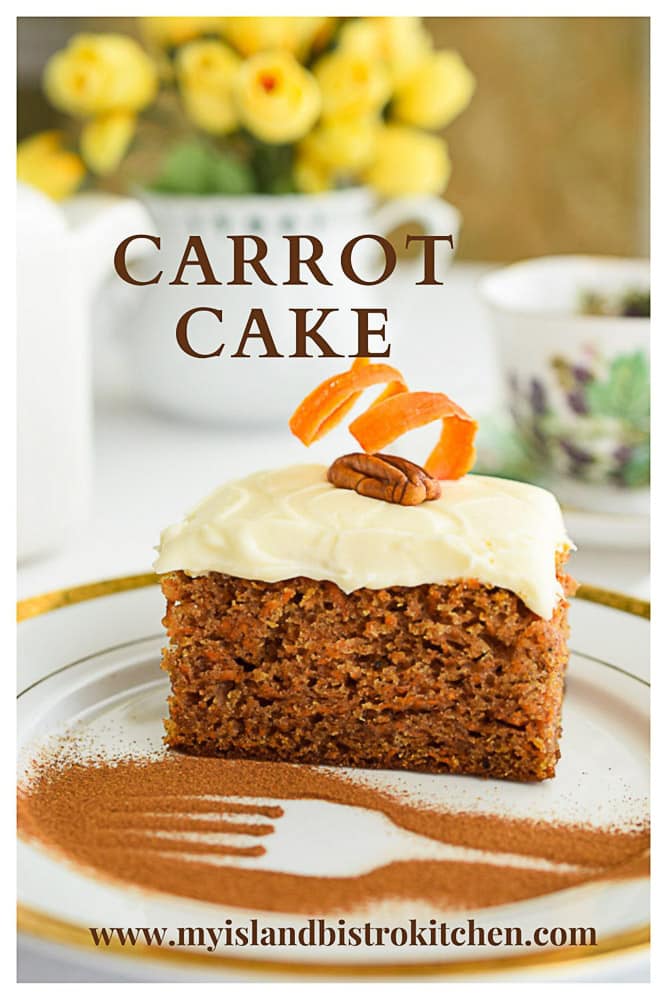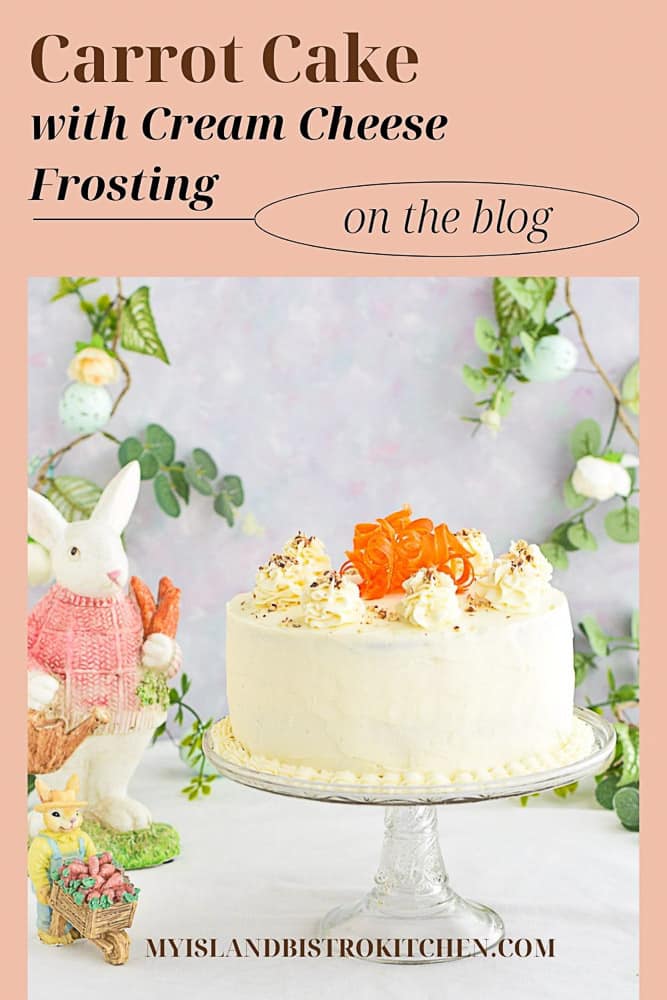
Some recipes just never grow old or go out of style and such is the case with this perfectly spiced, Classic Carrot Cake with Cream Cheese Frosting.

It’s hard to beat a good moist and flavorful Carrot Cake with a velvety soft, tender crumb. The moist texture of this cake comes from several ingredients – principally, the oil, sugar, eggs, sour cream, and, of course, the finely grated carrots.
Three-quarters of a pound of carrots will be required for this cake and they need to be finely grated. This should equate to approximately 3 cups of grated carrots or thereabouts, depending on the size of grater holes used and how the measuring cups are filled. The carrots should not be so finely grated that they are almost puréed but neither should they have large shreds that won’t break down as the cake bakes and you end up with big pieces of raw carrot in the cake. As you grate the carrots, you will see the moisture in the grated carrots and that, along with some other ingredients explained below, will translate into a lovely moist cake.
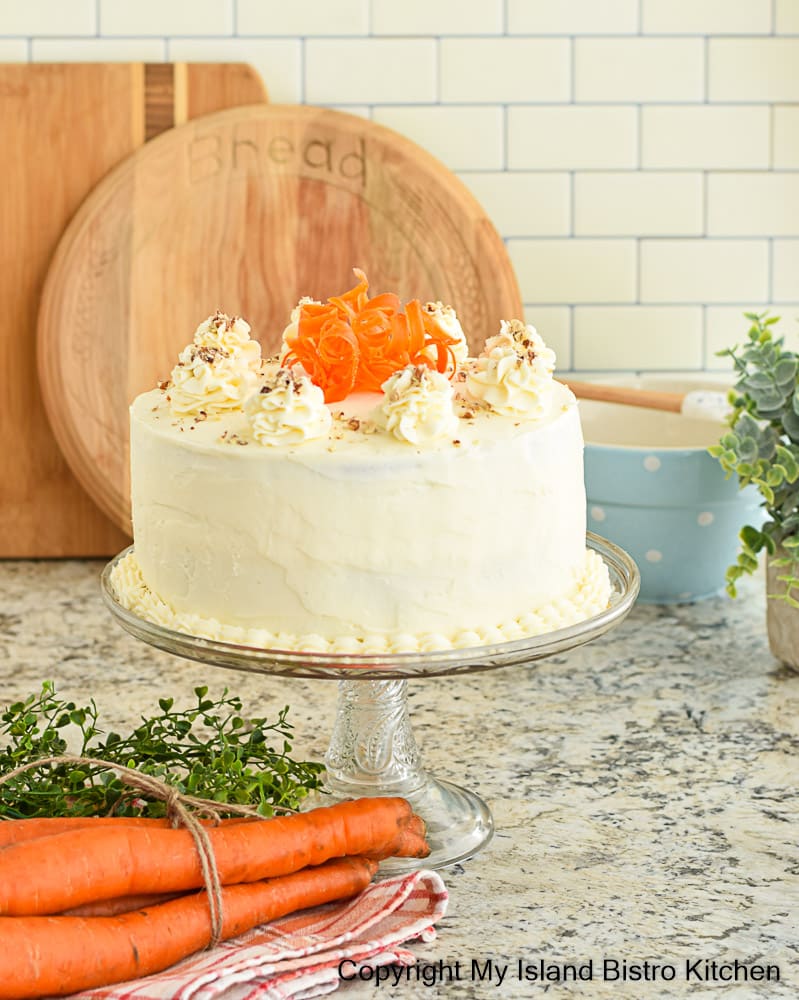
This Carrot Cake recipe calls for a mix of granulated and brown sugar with the latter contributing depth of flavor. However, if only all brown sugar alone was used, the cake would be very dark in color so a blend of the two types of sugar gives a better colored cake. Sugar performs several very important functions in this cake beyond the obvious sweetness factor.
In the case of a cake, like this Classic Carrot Cake, sugar helps to keep the texture soft and moist as it holds and traps moisture that comes from other ingredients like oil, sour cream, and the grated carrots themselves. Sugar locks in that moisture that will keep the cake moist and prevent it from drying out – a dry Carrot Cake is a disappointment just as much as a soggy one would be so the right amount of sugar is a balance.
Sugar plays a role in achieving a lovely tender textured cake. Because sugar grabs and traps moisture away from starches and proteins, it slows down and limits or weakens gluten development and, as we know, too much gluten results in tough, dense textured cakes.
Sugar also assists in leavening baked goods, too. When the sugar is beaten with whatever fat content is used in the recipe, along with the eggs, tiny bubbles are formed and those bubbles expand and assist with giving the cake loft and good volume as it bakes. So, any change in the amount of sugar a recipe calls for is likely to affect the texture, moistness, and rise of a cake resulting in potential reduced quality of the final baked product.
My recipe calls for sour cream and this is a product I use regularly in many baked goods for the value it imparts to the final product. Sour cream, firstly, activates the baking soda called for in the recipe. Secondly, it adds fabulous richness and moisture to the cake without thinning the batter as milk, for example, would do. Thirdly, sour cream tenderizes gluten strands (yes, the ones that have the potential to make a cake texture tough) and yields a lovely velvet-like and tender texture to many cakes. I recommend full-fat sour cream versus fat-reduced versions for this cake.
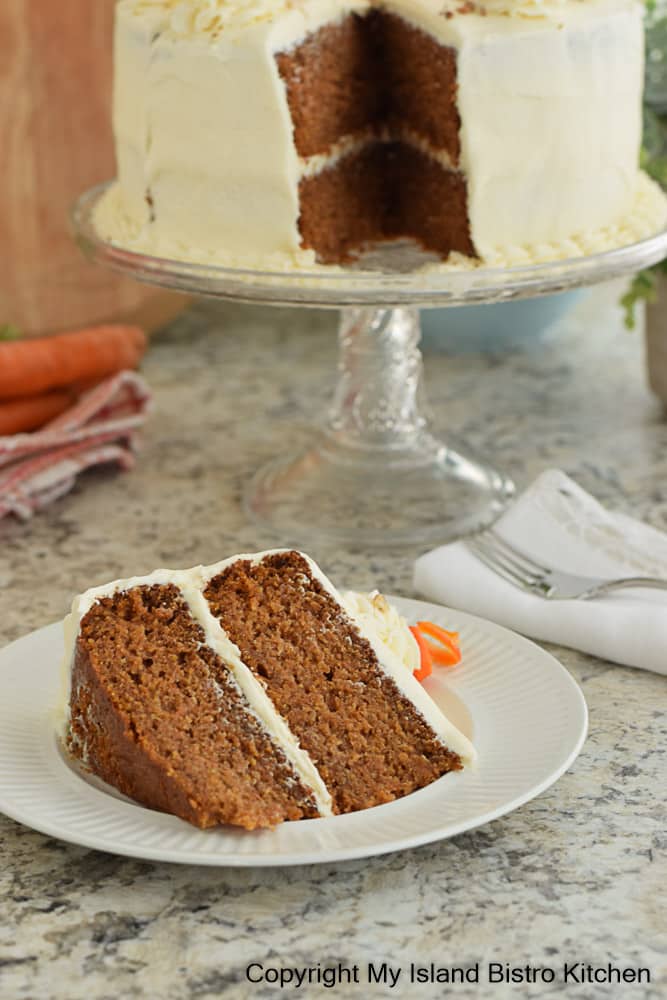
The dry ingredients in this cake are very basic and include a curated blend of warm spices. I don’t add raisins or nuts to my carrot cake but they could certainly be added, if desired.
I have tested my recipe with gluten-free 1-to-1 baking flour and it turns out beautifully, so much so that no one would guess it is gluten-free. So, if you are on a gluten-free diet, use gluten-free 1-to-1 or cup-for-cup baking flour and, of course, ensure that all other ingredients are gluten-free as well.
While I recommend parchment paper be used for the 8” cake pans as well as the 9”x13” pan, simply greasing the pans very well will work fine. The advantage of parchment paper is the easy removal of cakes from the pans intact without some of the cake sticking to the pans.
If you have insulated baking strips, I recommend using them for the two 8” cakes. These strips are great tools to help cakes rise nice and even. They reduce the amount of the top of each cake that needs to be levelled off to make them even when sandwiching them together to form a layer cake.

This cake can be baked in several different styles and sizes of pans. I have tested this recipe with three pans commonly used for carrot cake baking – two 8” round pans for a layer cake, a 9”x13” pan, and a 10” Bundt pan (Bundt cake shown in photograph above).
Baking times will vary for each pan and every oven heats and bakes differently. I have given guideline baking times for each of the three different cake pan sizes but, of course, the best gauge of doneness is when the cake starts to show signs of pulling away from the sides of the pan, springs back to a light touch, and a cake tester inserted into the center of the cake comes out clean. So, you will have to use some baking experience with this, particularly if you opt to use a pan that I have not tested and mentioned in the recipe. The cake batter should yield approximately 6 1/3 – 6½ cups of batter so, if you wish to bake it in a cake shape and size different from what I indicate here, know that you will need a pan, or pans, to accommodate this amount of batter.

[Printable Recipe Follows at end of Post]
Carrot Cake with Cream Cheese Frosting
Ingredients:
2 1/3 cups all-purpose flour
2 tsp baking powder
2 tsp baking soda
½ tsp salt
2 tsp cinnamon
¾ tsp nutmeg
½ tsp allspice
½ tsp cloves
1/8 tsp ginger
¾ cup granulated sugar
¾ cup brown sugar, packed
1 cup + 1 tbsp vegetable oil
4 large eggs, room temperature
½ cup sour cream, room temperature
2½ tsp vanilla
¾ lb raw carrots
Equipment Needed:
Scales
Grater
Stand or Hand Mixer
Method:
Bring eggs and sour cream to room temperature.
Position oven rack in center of oven and preheat oven to 350°F.
This cake may be baked in different pans. For a two-layer cake, line bottom of two 8”x2” round cake pans with parchment paper circles. Cut two lengths of parchment paper, each about 28” long and 2¾“ wide for lining sides of pans. Lightly spray pans before lining with parchment paper to hold the paper in place. Cake may also be baked in 9”x13” pan lined with parchment paper or in a 10” well-greased Bundt pan (ensure all crevices in pan are very well greased).
In medium-sized bowl, sift or sieve the dry ingredients together.
In bowl of stand mixer fitted with paddle attachment, combine the granulated and brown sugars. Add the oil and blend into the sugar at medium low speed. With mixer set to medium speed, beat in the eggs, one at a time, stopping as necessary to scrape sides of bowl with rubber or silicone spatula. Beat for approximately 30 seconds after last egg has been added. Beat in the sour cream followed by the vanilla, beating just until ingredients are well blended. Do not overbeat.
With mixer set to slowest speed, gradually add the dry ingredients, about 2/3 cup at a time, until blended. Increase speed to medium and beat ingredients about 30 seconds.
Remove bowl from mixer stand and fold in grated carrots.
For two 8”x2” round cake pans: Divide mixture evenly between prepared pans. Smooth batter with knife or offset spatula. Bake for approximately 30-40 minutes (see Note below), or until cakes show signs of starting to pull away from sides of pans and spring back to a light touch and a cake tester inserted into centers of cakes comes out clean. Transfer pans to wire rack and allow cakes to cool in pans 10 minutes. Carefully remove the rings of parchment paper from around each cake and invert cakes on to wire rack(s). Remove parchment paper from cake bottoms and cool cakes completely before assembling layer cake and frosting.
For 9”x13” pan: Transfer batter to pan. Smooth batter with knife or offset spatula. Bake for approximately 35-40 minutes (see Note below) or until cake show signs of starting to pull away from sides of pans and spring back to a light touch and a cake tester inserted into centers of cakes comes out clean. Transfer pan to wire rack and cool cake in pan for 10 minutes then invert cake onto wire rack. Remove parchment paper from cake and cool cake completely before frosting.
For 10” Bundt pan: Transfer batter to pan. Smooth batter with knife or offset spatula. Bake for approximately 50-60 minutes (see Note below), or until cake shows signs of starting to pull away from sides of pan and springs back to a light touch and a cake tester inserted into center of cake comes out clean. Transfer cake to wire rack and allow cake to cool in pan for 10 minutes then invert cake on to a wire rack to cool completely before frosting.
When cakes are completely cool, frost as desired with Cream Cheese Frosting (recipe below)
NOTES:
1. Two 8” round cake pans or 9”x13” pan can be greased in lieu of using parchment paper; however, parchment paper provides the greatest assurance of the cakes being removed from the pan(s) intact and without sticking to the pan(s).
2. Wrapping insulated baking strips around the 8” baking pans will help to keep the cakes even as they rise and reduce the amount of cake that needs to be removed from the cake tops when cakes are assembled into a layer cake.
3. Baking times are a guideline only as every oven heats and bakes differently. When cake shows signs of starting to pull away from sides of the pan, springs back to a light touch, and a cake tester comes out clean when inserted into center of cake, cake is baked. Start checking cake(s) for doneness at the earliest time suggested in the recipe and, if not baked, bake until the aforementioned conditions are met.
For the Cream Cheese Frosting, be sure to sift or sieve the icing sugar before weighing it. If you don’t have a sifter, use a fine wire mesh sieve. Sifting/sieving the icing sugar aerates it and removes any lumps that may be in it. This will help create a light, fluffy and smooth textured frosting as it helps the other ingredients blend well with the fluffy icing sugar and also prevents a lumpy frosting from occurring.
Cream Cheese Frosting
Ingredients:
8 oz cream cheese, softened to room temperature
½ cup butter, room temperature
2 tsp pure vanilla extract
2 tsp milk
1 lb sifted icing (confectioner’s/powdered) sugar (weighed after sifted/sieved)
Method:
Bring cream cheese, butter, and milk to room temperature.
Sift or sieve the icing sugar to aerate it and remove any lumps. Measure out one pound of the sifted/sieved icing sugar.
With mixer set at medium speed, beat cream cheese and butter until creamy and well-blended. Beat in vanilla and milk. Add about one-third of the icing sugar. Beat well to blend. Add remaining icing sugar in two separate additions, beating well after each addition and scraping bowl often with rubber or silicone spatula to ensure sugar is well blended into creamed mixture. Beat for 1-2 minutes longer until frosting is smooth, light, and fluffy.
Yield: Enough frosting to fill and completely frost 1 – 8” layer cake, a 10” Bundt cake, and ample for 9”x13” cake. Additional one-half recipe of frosting may be required for decorative piping, if desired. Any leftover frosting may be frozen for future use.
To assemble two-layer cake (with two 8” round cakes):
Even each cake top by using a cake leveller or knife, ensuring both cakes are the same height. Lightly brush away any loose crumbs remaining on the sides of the cakes. Sandwich together the two cake layers with a generous amount of cream cheese frosting. Apply a light crumb coat to top and sides of cake. Refrigerate for about 45-60 minutes to allow the frosting to set then coat cake top and sides with remaining frosting. Alternatively, frost only the top of cake and leave the sides without frosting for a more rustic looking cake.
For 9”x13” cake, or Bundt cake, cover with frosting.
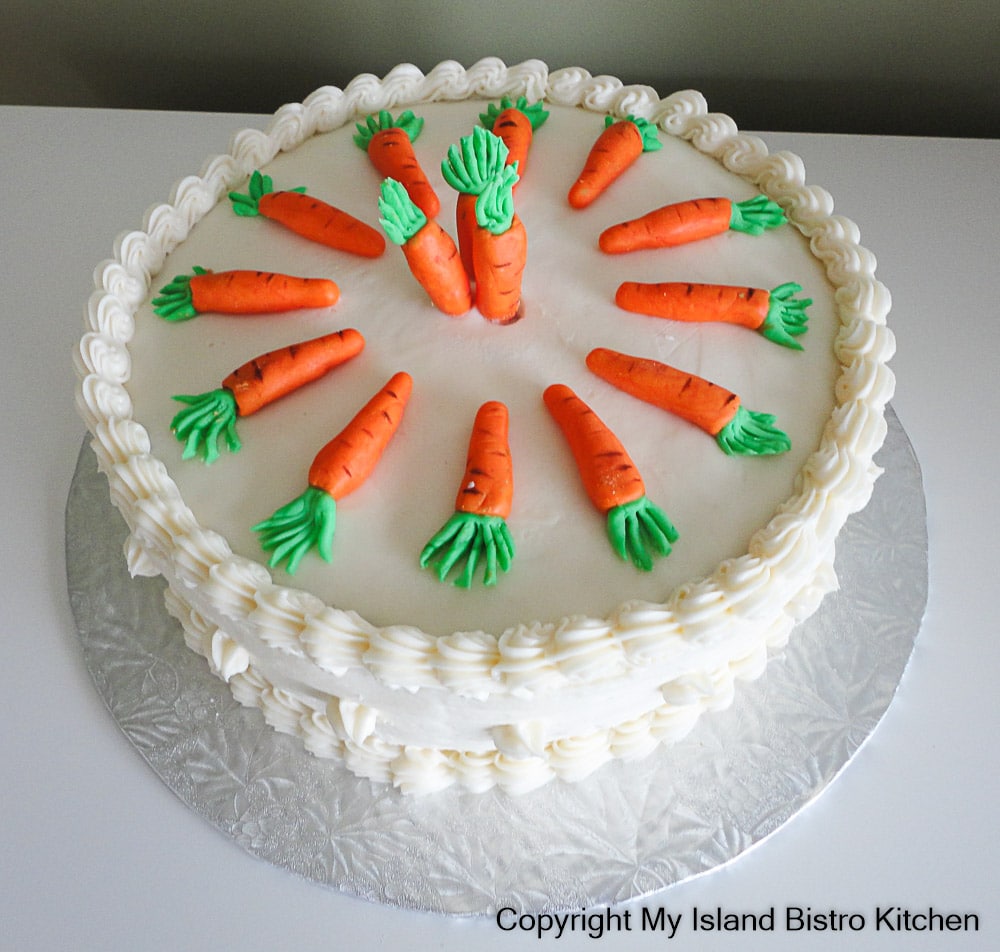
You may also enjoy these other cake recipes from My Island Bistro Kitchen:
Vintage Tomato Soup Layer Cake
Rhubarb Pudding Cake
Country Farmhouse Crumb Cake
Queen Elizabeth Cake
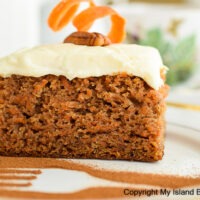
Carrot Cake
Ingredients
- 2 1/3 cups all-purpose flour
- 2 tsp baking powder
- 2 tsp baking soda
- ½ tsp salt
- 2 tsp cinnamon
- ¾ tsp nutmeg
- ½ tsp allspice
- ½ tsp cloves
- 1/8 tsp ginger
- ¾ cup granulated sugar
- ¾ cup brown sugar, packed
- 1 cup + 1 tbsp vegetable oil
- 4 large eggs, room temperature
- ½ cup sour cream, room temperature
- 2½ tsp vanilla
- ¾ lb raw carrots
Instructions
- Bring eggs and sour cream to room temperature.
Position oven rack in center of oven and preheat oven to 350°F.
This cake may be baked in different pans. For a two-layer cake, line bottom of two 8”x2” round cake pans with parchment paper circles. Cut two lengths of parchment paper, each about 28” long and 2¾“ wide for lining sides of pans. Lightly spray pans before lining with parchment paper to hold the paper in place. Cake may also be baked in 9”x13” pan lined with parchment paper or in a 10” well-greased Bundt pan (ensure all crevices in pan are very well greased).
- In medium-sized bowl, sift or sieve the dry ingredients together.
- In bowl of stand mixer fitted with paddle attachment, combine the granulated and brown sugars. Add the oil and blend into the sugar at medium low speed. With mixer set to medium speed, beat in the eggs, one at a time, stopping as necessary to scrape sides of bowl with rubber or silicone spatula. Beat for approximately 30 seconds after last egg has been added. Beat in the sour cream followed by the vanilla, beating just until ingredients are well blended. Do not overbeat.
- With mixer set to slowest speed, gradually add the dry ingredients, about 2/3 cup at a time, until blended. Increase speed to medium and beat ingredients about 30 seconds.
- Remove bowl from mixer stand and fold in grated carrots.
For two 8”x2” round cake pans: Divide mixture evenly between prepared pans. Smooth batter with knife or offset spatula. Bake for approximately 30-40 minutes (see Note below), or until cakes show signs of starting to pull away from sides of pans and spring back to a light touch and a cake tester inserted into centers of cakes comes out clean. Transfer pans to wire rack and allow cakes to cool in pans 10 minutes. Carefully remove the rings of parchment paper from around each cake and invert cakes on to wire rack(s). Remove parchment paper from cake bottoms and cool cakes completely before assembling layer cake and frosting.
For 9”x13” pan: Transfer batter to pan. Smooth batter with knife or offset spatula. Bake for approximately 35-40 minutes (see Note below) or until cake shows signs of starting to pull away from sides of pans and springs back to a light touch and a cake tester inserted into center of cake comes out clean. Transfer pan to wire rack and cool cake in pan for 10 minutes then invert cake onto wire rack. Remove parchment paper from cake and cool cake completely before frosting.
For 10” Bundt pan: Transfer batter to pan. Smooth batter with knife or offset spatula. Bake for approximately 50-60 minutes (see Note below), or until cake shows signs of starting to pull away from sides of pan and springs back to a light touch and a cake tester inserted into centers of cakes comes out clean Transfer cake to wire rack and allow cake to cool in pan for 10 minutes then invert cake on to a wire rack to cool completely before frosting.
When cakes are completely cool, frost as desired with Cream Cheese Frosting.
Recipe Notes
NOTES:
1. Two 8” round cake pans or 9”x13” pan can be greased in lieu of using parchment paper; however, parchment paper provides the greatest assurance of the cakes being removed from the pan(s) intact and without sticking to the pan(s).
2. Wrapping insulated baking strips around the 8” baking pans will help to keep the cakes even as they rise and reduce the amount of cake that needs to be removed from the cake tops when cakes are assembled into a layer cake.
3. Baking times are a guideline only as every oven heats and bakes differently. When cake shows signs of starting to pull away from sides of the pan, springs back to a light touch, and a cake tester comes out clean when inserted into center of cake, cake is baked. Start checking cake(s) for doneness at the earliest time suggested in the recipe and, if not baked, bake until the aforementioned conditions are met.
Copyright My Island Bistro Kitchen 2023
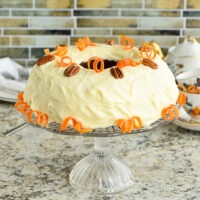
Cream Cheese Frosting
Ingredients
- 8 oz cream cheese, softened to room temperature
- ½ cup butter, room temperature
- 2 tsp pure vanilla extract
- 2 tsp milk
- 1 lb sifted/sieved icing (confectioner’s/powdered) sugar (weighed after sifted/sieved)
Instructions
- Bring cream cheese, butter, and milk to room temperature.
Sift or sieve the icing sugar to aerate it and remove any lumps. Measure out one pound of the sifted/sieved icing sugar.
- With mixer set at medium speed, beat cream cheese and butter until creamy and well-blended. Beat in vanilla and milk. Add about one-third of the icing sugar. Beat well to blend. Add remaining icing sugar in two separate additions, beating well after each addition and scraping bowl often with rubber or silicone spatula to ensure sugar is well blended into creamed mixture. Beat for 1-2 minutes longer until frosting is smooth, light, and fluffy.
Yield: Enough frosting to fill and completely frost 1 – 8” layer cake, a 10” Bundt cake, and ample for 9”x13” cake. Additional one-half recipe of frosting may be required for decorative piping, if desired. Any leftover frosting may be frozen for future use.
To assemble two-layer cake (with two 8” round cakes):
Even each cake top by using a cake leveller or knife, ensuring both cakes are the same height. Lightly brush away any loose crumbs remaining on the sides of the cakes. Sandwich together the two cake layers with a generous amount of cream cheese frosting. Apply a light crumb coat to top and sides of cake. Refrigerate for about 45-60 minutes to allow the frosting to set then coat cake top and sides with remaining frosting. Alternatively, frost only the top of cake and leave the sides without frosting for a more rustic looking cake.
- For 9”x13” cake, or Bundt cake, cover with frosting.
Recipe Notes
Copyright My Island Bistro Kitchen 2023
If you have made this recipe and enjoyed it and/or wish to share it with your friends and family, please do so on social media but be sure to share the direct link to this posting from my website.
Connect with My Island Bistro Kitchen on Social Media
Join the Facebook page for My Island Bistro Kitchen: https://www.facebook.com/MyIslandBistroKitchen/
Follow “the Bistro” on “X” (formerly Twitter): https://twitter.com/PEIBistro/
See the drool-worthy gallery of mouth-watering food photos from My Island Bistro Kitchen on Instagram: https://www.instagram.com/peibistro/
Follow “the Bistro” on Pinterest at https://www.pinterest.ca/peibistro/ and pin the Pinterest-ready photo at the end of this posting to your favorite Pinterest boards!
PIN ME TO PINTEREST FOR LATER!
